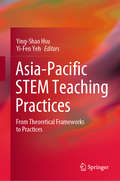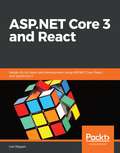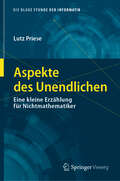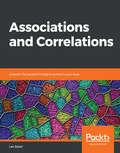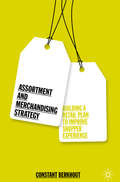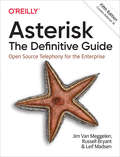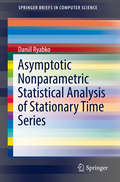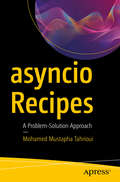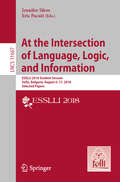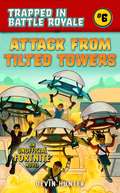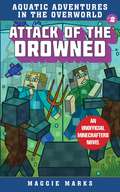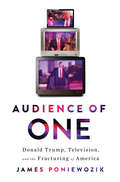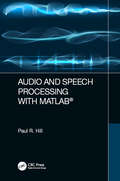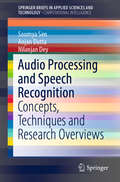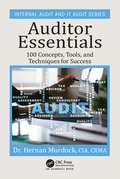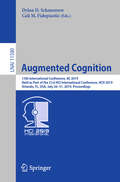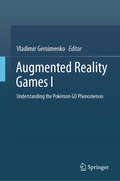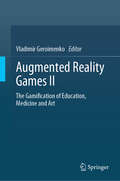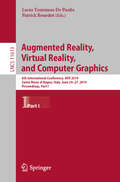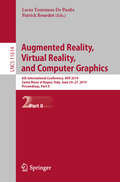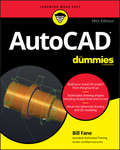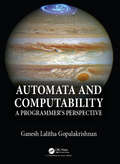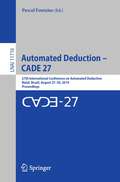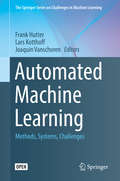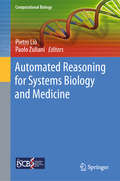- Table View
- List View
Asia-Pacific STEM Teaching Practices: From Theoretical Frameworks to Practices
by Ying-Shao Hsu Yi-Fen YehThis book offers various perspectives on the complex and crosscutting concepts of the science, technology, engineering, and mathematics (STEM) disciplines in the classroom context. Presenting empirical studies, it reveals how researchers in the Asia-Pacific Region planned and implemented STEM education in the classroom. Further, it discusses the assessment of STEM learning to clarify what important elements should be included and how researchers and educators frame and design assessment tools. The book consists of four parts: potential and trends in STEM education; teachers’ practical knowledge for STEM teaching; STEM teaching practices; and assessment of STEM learning. Providing evidence on developing curriculums, implementing instructional practices and educating classroom teachers, it is intended for readers wanting to explore STEM education from multiple perspectives.
ASP.NET Core 3 and React: Hands-On full stack web development using ASP.NET Core, React, and TypeScript 3
by Carl RipponBuild modern, scalable, and cloud-ready single-page applications using ASP.NET Core, React, TypeScript, and Azure Key Features Explore the full potential and latest features of .NET Core 3.0, TypeScript 3, and React Learn how to manage data, application design, and packaging, and secure your web apps Discover best practices for using React and TypeScript to build a scalable frontend that interacts with REST APIs Book Description Microsoft's ASP.NET Core is a robust and high-performing cross-platform web API framework, and Facebook's React uses declarative JavaScript to drive a rich, interactive user experience on the client-side web. Together, they can be used to build full stack apps with enhanced security and scalability at each layer. This book will start by taking you through React and TypeScript components to build an intuitive single-page application. You'll understand how to design scalable REST APIs that can integrate with a React-based frontend. You'll get to grips with the latest features, popular patterns, and tools available in the React ecosystem, including function-based components, React Router, and Redux. The book shows how you can use TypeScript along with React to make the frontend robust and maintainable. You'll then cover important .NET Core features such as API controllers, attribute routing, and model binding to help you build a sturdy backend. Additionally, you'll explore API security with ASP.NET Core identity and authorization policies, and write reliable unit tests using both .NET Core and React before you deploy your app to the Azure cloud. By the end of the book, you'll have gained all the knowledge you need to enhance your C# and JavaScript skills and build full stack, production-ready applications with ASP.NET Core and React. What you will learn Build RESTful APIs with .NET Core using API controllers Create strongly typed, interactive, and function-based React components using Hooks Build forms efficiently using reusable React components Perform client-side state management with Redux and the React Context API Secure REST APIs with ASP.NET identity and authorization policies Run a range of automated tests on the frontend and backend Implement continuous integration (CI) and continuous delivery (CD) processes into Azure using Azure DevOps Who this book is for If you're a web developer looking to build solid full-stack web applications with .NET Core and React, this book is for you. Although this book does not assume any knowledge of React, you're expected to have a basic understanding of .NET Core.
Aspekte des Unendlichen: Eine kleine Erzählung für Nichtmathematiker (Die blaue Stunde der Informatik)
by Lutz PrieseEin Buch über die Unendlichkeit Wer glaubt, dass sich Rechnen auf trockene Formeln und Zahlen beschränkt, wird mit „Aspekte des Unendlichen – Eine kleine Erzählung für Nichtmathematiker“ sein blaues Wunder erleben. Dieses Buch spricht alle Leser an, die nicht nur die Logik, sondern auch die Poesie der Unendlichkeit erforschen möchten. Anstatt Laien mit kryptischem Akademikerjargon zu verwirren, übersetzt es komplexe Sachverhalte in leicht verständliche Erklärungen. So können auch Einsteiger erfahren, welche Überraschungen die Mengenlehre bereithält. Von nicht abzählbaren Größen und unentscheidbaren Fragen Die Wissenschaft der mathematischen Unendlichkeit umfasst zahlreiche Problemstellungen, die ebenso anspruchsvoll wie spannend sind. Dazu gehören unter anderem:· die Bibliothek von Babel· diskontinuierliche Kontinua· Unmengen· Paradoxien und Antinomien Um solche theoretischen Ansätze in ihren Grundzügen zu begreifen, braucht es keinen Hochschulabschluss. Lutz Prieses Buch über die Mathematik der Unendlichkeit verwandelt abstrakte Konzepte in lebensnahe Zusammenhänge. Der Autor ist promovierter Logiker und hält seit seiner Pensionierung regelmäßig Vorlesungen zu Themen der Mathematik und Informatik. Dank seiner langjährigen Tätigkeit als Hochschuldozent gelingt es ihm, mit einer unterhaltsamen Sprache Anfänger und Experten gleichermaßen zu fesseln. Dabei steht vor allem die Verbindung zwischen mathematischen und philosophischen Problemen im Vordergrund:· Wie genau können wir mit Zahlen die unendlichen Weiten des Weltalls erfassen?· Inwiefern spiegeln die Grenzen des Rechnens die Grenzen des menschlichen Daseins wider?· Wie können wir Unvorstellbares vorstellbar machen? Prieses Buch über die Unendlichkeit in der Mathematik liefert keine endgültigen Antworten auf diese Fragen. Vielmehr regt es Leser dazu an, sich selbst auf die Suche zu machen und eigene Ideen zu entwickeln. Wie es der Titel verspricht, lädt „Aspekte des Unendlichen“ zu einer schier endlosen Reise durch die Gedankenwelt ein.
Associations and Correlations: Unearth the powerful insights buried in your data
by Lee BakerDiscover the story of your data using the essential elements of associations and correlations Key Features Get a comprehensive introduction to associations and correlations Explore multivariate analysis, understand its limitations, and discover the assumptions on which it's based Gain insights into the various ways of preparing your data for analysis and visualization Book Description Associations and correlations are ways of describing how a pair of variables change together as a result of their connection. By knowing the various available techniques, you can easily and accurately discover and visualize the relationships in your data. This book begins by showing you how to classify your data into the four distinct types that you are likely to have in your dataset. Then, with easy-to-understand examples, you'll learn when to use the various univariate and multivariate statistical tests. You'll also discover what to do when your univariate and multivariate results do not match. As the book progresses, it describes why univariate and multivariate techniques should be used as a tag team, and also introduces you to the techniques of visualizing the story of your data. By the end of the book, you'll know exactly how to select the most appropriate univariate and multivariate tests, and be able to use a single strategic framework to discover the true story of your data. What you will learn Identify a dataset that's fit for analysis using its basic features Understand the importance of associations and correlations Use multivariate and univariate statistical tests to confirm relationships Classify data as qualitative or quantitative and then into the four subtypes Build a visual representation of all the relationships in the dataset Automate associations and correlations with CorrelViz Who this book is for This is a book for beginners – if you're a novice data analyst or data scientist, then this is a great place to start. Experienced data analysts might also find value in this title, as it will recap the basics and strengthen your understanding of key concepts. This book focuses on introducing the essential elements of association and correlation analysis.
Assortment and Merchandising Strategy: Building a Retail Plan to Improve Shopper Experience
by Constant BerkhoutDemonstrating how retailers can tap into shoppers’ needs for variety without increasing complexity and stress, this innovative book combines cutting-edge research with hands-on, practical frameworks. Experts in the retail sector have long been convinced that small assortments are more appealing to shoppers than large selections of products; in other words, less is more. However, the human brain has an innate need for variety. Addressing this challenge Constant Berkhout offers practical merchandising guidelines both for stores and online retailers. Indeed, studies show that it is not the actual size of assortment that drives traffic to online stores, but the perception of assortment variety. The author illustrates how decisions around assortment and visual merchandising must be made in conjunction with each other, rather than separately, and provides a step-by-step plan to do so. Grounded on shopper needs, emotions and behaviours that apply to both online and brick-and-mortar stores, this book integrates assortment and merchandise thinking and takes a human and shopper perspective. With practical frameworks that can easily be implemented in real-life situations along with examples from a number of retail sectors, Assortment and Merchandising Strategy provides a deeper and much-needed understanding of how shoppers process information, and the strategies that retailers must adopt in order to satisfy and retain their customers.
Asterisk: The Definitive Guide
by Russell Bryant Leif Madsen Jim MeggelenDesign a complete Voice over IP (VoIP) or traditional PBX system with Asterisk, even if you have only basic telecommunications knowledge. This bestselling guide makes it easy with a detailed roadmap that shows you how to install and configure this open source software, whether you’re upgrading your existing phone system or starting from scratch.Ideal for Linux administrators, developers, and power users, this updated fifth edition shows you how to write a basic dialplan step-by-step and brings you up to speed on the features in Asterisk 16, the latest long-term support release from Digium. You’ll quickly gain working knowledge to build a simple yet inclusive system. Integrate Asterisk with analog, VoIP, and digital telephony systems; Build an interactive dialplan using best practices for more advanced features; Delve into voicemail options such as storing messages in a database; Connect to external services including Google Hangouts, XMPP, and calendars; Incorporate Asterisk features and functions into a relational database to facilitate information sharing; Learn how to use Asterisk’s security, call routing, and faxing features; Monitor and control your system with the Asterisk Manager Interface (AMI).
Asymptotic Nonparametric Statistical Analysis of Stationary Time Series (SpringerBriefs in Computer Science)
by Daniil RyabkoStationarity is a very general, qualitative assumption, that can be assessed on the basis of application specifics. It is thus a rather attractive assumption to base statistical analysis on, especially for problems for which less general qualitative assumptions, such as independence or finite memory, clearly fail. However, it has long been considered too general to be able to make statistical inference. One of the reasons for this is that rates of convergence, even of frequencies to the mean, are not available under this assumption alone. Recently, it has been shown that, while some natural and simple problems, such as homogeneity, are indeed provably impossible to solve if one only assumes that the data is stationary (or stationary ergodic), many others can be solved with rather simple and intuitive algorithms. The latter include clustering and change point estimation among others. In this volume I summarize these results. The emphasis is on asymptotic consistency, since this the strongest property one can obtain assuming stationarity alone. While for most of the problem for which a solution is found this solution is algorithmically realizable, the main objective in this area of research, the objective which is only partially attained, is to understand what is possible and what is not possible to do for stationary time series. The considered problems include homogeneity testing (the so-called two sample problem), clustering with respect to distribution, clustering with respect to independence, change point estimation, identity testing, and the general problem of composite hypotheses testing. For the latter problem, a topological criterion for the existence of a consistent test is presented. In addition, a number of open problems is presented.
asyncio Recipes: A Problem-Solution Approach
by Mohamed Mustapha TahriouiGet the most out of asyncio and find solutions to your most troubling Python programming problems. This book offers a pragmatic collection of recipes by going beyond online resources and docs to provide guidance on using this complex library. As such, you’ll see how to improve application performance and run computationally intensive programs faster.asyncio Recipes starts with examples illustrating the primitives that come with the asyncio library, and explains how to determine if asyncio is the right choice for your application. It shows how to use asyncio to yield performance gains without multiple threads, and identifies common mistakes and how to prevent them. Later chapters cover error-handling, testing, and debugging. By the end of this book, you'll understand how asyncio runs behind the scenes, and be confident enough to contribute to asyncio-first projects.What You Will LearnDiscover quirky APIs such as the event loop policiesWrite asyncio code with native coroutines Use the ast module to find legacy asyncio codeWork with contextvars See what a async context manager is and why a lot of asyncio APIs use themWho This Book Is ForExperienced Python developers or hobbyists who want to understand asyncio and speed up their applications by adding concurrency to their toolkit.
At the Intersection of Language, Logic, and Information: ESSLLI 2018 Student Session, Sofia, Bulgaria, August 6–17, 2018, Selected Papers (Lecture Notes in Computer Science #11667)
by Jennifer Sikos Eric PacuitThe European Summer School in Logic, Language and Information (ESSLLI) is organized every year by the Association for Logic, Language and Information (FoLLI) in different sites around Europe. The papers cover vastly dierent topics, but each fall in the intersection of the three primary topics of ESSLLI: Logic, Language and Computation. The 14 papers presented in this volume have been selected among 24 papers presented by talks or posters at the Student Sessions of the 30th edition of ESSLLI, held in 2018 in Sofia, Bulgaria.The Student Session is a forum for PhD and Master students to present their research at the interfaces of logic, language and computation. It features three tracks: Logic and Computation (LoCo), Logic and Language (LoLa), and Language and Computation (LaCo).
Attack from Tilted Towers: An Unofficial Novel of Fortnite (Trapped In Battle Royale)
by Devin HunterWith Tae Min’s help, Grey’s squad reaches the top ten, but every game changes who will stay trapped in Fortnite Battle Royale and who will go home. There are only three days of battles left, and Grey isn’t sure it’s enough to secure top five for his whole squad. His rank is higher than his friends, and it starts to look like he’ll get home like he wanted. But someone he cares about will have to stay, and Grey has to make a choice: give up his spot or leave his friends. Either choice will mean losing something, but Grey must decide if what’s gained is worth more.
Attack of the Drowned: An Unofficial Minecrafters Novel (Aquatic Adventures in the Overworld #2)
by Maggie MarksIntroducing the second novel of the brand-new series about the aquatic world of Minecraft! Brothers Mason and Asher have only ever known the comfort of dry land in the Overworld. But when a terrifying shipwreck leaves them stranded, their new friend Luna urges them to safe haven—underwater. In each story of the all-new series for Minecrafters, Aquatic Adventures in the Overworld, this unlikely trio must make the choice of staying in the world they know best and risk death, or voyaging into an unknown world where anything could happen. Follow their journey as Mason, Asher, and Luna face incredible obstacles and discover strength they never knew they had in Aquatic Adventures in the Overworld. In the second novel of their aquatic adventures, Mason and Asher&’s underwater base seems safe and peaceful, except for the fish-beast guardians that swim past. But when glowing eyes appear—watching the brothers through their glass walls—they realize they&’re trapped. The Drowned are everywhere! Food is running low and a leaking roof threatens to cave in. Will Luna arrive in time to help, or will Mason need to leave his home and face the Drowned head-on?
Audience of One: Donald Trump, Television And The Fracturing Of America
by James PoniewozikOne of the Top 10 Politics and Current Events Books of Fall 2019 (Publishers Weekly) An incisive cultural history that captures a fractious nation through the prism of television and the rattled mind of a celebrity president. Television has entertained America, television has ensorcelled America, and with the election of Donald J. Trump, television has conquered America. In Audience of One, New York Times chief television critic James Poniewozik traces the history of TV and mass media from the Reagan era to today, explaining how a volcanic, camera-hogging antihero merged with America’s most powerful medium to become our forty-fifth president. In the tradition of Neil Postman’s masterpiece Amusing Ourselves to Death, Audience of One shows how American media have shaped American society and politics, by interweaving two crucial stories. The first story follows the evolution of television from the three-network era of the 20th century, which joined millions of Americans in a shared monoculture, into today’s zillion-channel, Internet-atomized universe, which sliced and diced them into fractious, alienated subcultures. The second story is a cultural critique of Donald Trump, the chameleonic celebrity who courted fame, achieved a mind-meld with the media beast, and rode it to ultimate power. Braiding together these disparate threads, Poniewozik combines a cultural history of modern America with a revelatory portrait of the most public American who has ever lived. Reaching back to the 1940s, when Trump and commercial television were born, Poniewozik illustrates how Donald became “a character that wrote itself, a brand mascot that jumped off the cereal box and entered the world, a simulacrum that replaced the thing it represented.” Viscerally attuned to the media, Trump shape-shifted into a boastful tabloid playboy in the 1980s; a self-parodic sitcom fixture in the 1990s; a reality-TV “You’re Fired” machine in the 2000s; and finally, the biggest role of his career, a Fox News–obsessed, Twitter-mad, culture-warring demagogue in the White House. Poniewozik deconstructs the chaotic Age of Trump as the 24-hour TV production that it is, decoding an era when politics has become pop culture, and vice versa. Trenchant and often slyly hilarious, Audience of One is a penetrating and sobering review of the raucous, raging, farcical reality show—performed for the benefit of an insomniac, cable-news-junkie “audience of one”—that we all came to live in, whether we liked it or not.
Audio and Speech Processing with MATLAB
by Paul HillSpeech and audio processing has undergone a revolution in preceding decades that has accelerated in the last few years generating game-changing technologies such as truly successful speech recognition systems; a goal that had remained out of reach until very recently. This book gives the reader a comprehensive overview of such contemporary speech and audio processing techniques with an emphasis on practical implementations and illustrations using MATLAB code. Core concepts are firstly covered giving an introduction to the physics of audio and vibration together with their representations using complex numbers, Z transforms and frequency analysis transforms such as the FFT. Later chapters give a description of the human auditory system and the fundamentals of psychoacoustics. Insights, results, and analyses given in these chapters are subsequently used as the basis of understanding of the middle section of the book covering: wideband audio compression (MP3 audio etc.), speech recognition and speech coding. The final chapter covers musical synthesis and applications describing methods such as (and giving MATLAB examples of) AM, FM and ring modulation techniques. This chapter gives a final example of the use of time-frequency modification to implement a so-called phase vocoder for time stretching (in MATLAB). Features A comprehensive overview of contemporary speech and audio processing techniques from perceptual and physical acoustic models to a thorough background in relevant digital signal processing techniques together with an exploration of speech and audio applications. A carefully paced progression of complexity of the described methods; building, in many cases, from first principles. Speech and wideband audio coding together with a description of associated standardised codecs (e.g. MP3, AAC and GSM). Speech recognition: Feature extraction (e.g. MFCC features), Hidden Markov Models (HMMs) and deep learning techniques such as Long Short-Time Memory (LSTM) methods. Book and computer-based problems at the end of each chapter. Contains numerous real-world examples backed up by many MATLAB functions and code.
Audio Processing and Speech Recognition: Concepts, Techniques and Research Overviews (SpringerBriefs in Applied Sciences and Technology)
by Soumya Sen Anjan Dutta Nilanjan DeyThis book offers an overview of audio processing, including the latest advances in the methodologies used in audio processing and speech recognition. First, it discusses the importance of audio indexing and classical information retrieval problem and presents two major indexing techniques, namely Large Vocabulary Continuous Speech Recognition (LVCSR) and Phonetic Search. It then offers brief insights into the human speech production system and its modeling, which are required to produce artificial speech. It also discusses various components of an automatic speech recognition (ASR) system. Describing the chronological developments in ASR systems, and briefly examining the statistical models used in ASR as well as the related mathematical deductions, the book summarizes a number of state-of-the-art classification techniques and their application in audio/speech classification. By providing insights into various aspects of audio/speech processing and speech recognition, this book appeals a wide audience, from researchers and postgraduate students to those new to the field.
Auditor Essentials: 100 Concepts, Tips, Tools, and Techniques for Success (Internal Audit and IT Audit)
by Hernan MurdockInternal auditors must know many concepts, techniques, control frameworks, and remain knowledgeable despite the many changes occurring in the marketplace and their profession. This easy to use reference makes this process easier and ensures auditors can obtain needed information quickly and accurately. This book consists of 100 topics, concepts, tips, tools and techniques that relate to how internal auditors interact with internal constitutencies and addresses a variety of technical and non-technical subjects. Non-auditors have an easy-to-use guide that increases their understanding of what internal auditors do and how, making it easier for them to partner with them more effectively.
Augmented Cognition: 13th International Conference, AC 2019, Held as Part of the 21st HCI International Conference, HCII 2019, Orlando, FL, USA, July 26–31, 2019, Proceedings (Lecture Notes in Computer Science #11580)
by Dylan D. Schmorrow Cali M. FidopiastisThis book constitutes the refereed proceedings of the 13th International Conference on Augmented Cognition, AC 2019, held as part of the 21st International Conference on Human-Computer Interaction, HCII 2019, in Orlando, FL, USA in July, 2019. The 1274 full papers and 209 posters presented at the HCII 2019 conferences were carefully reviewed and selected from 5029 submissions. The papers cover the entire field of human-computer interaction, addressing major advances in knowledge and effective use of computers in a variety of applications areas. The papers in this volume are organized in the following topical sections: cognitive modeling, perception, emotion and interaction; human cognition and behavior in complex tasks and environments; brain-computer interfaces and electroencephalography; and augmented learning.
Augmented Reality Games I: Understanding the Pokémon GO Phenomenon
by Vladimir GeroimenkoThis is the first of two comprehensive volumes that provide a thorough and multi-faceted research into the emerging field of augmented reality games and consider a wide range of its major issues. These first ever research monographs on augmented reality games have been written by a team of 70 leading researchers, practitioners and artists from 20 countries. In Volume I, the phenomenon of the Pokémon GO game is analysed in theoretical, cultural and conceptual contexts, with emphasis on its nature and the educational use of the game in children and adolescents. Game transfer phenomena, motives for playing Pokémon GO, players’ experiences and memorable moments, social interaction, long-term engagement, health implications and many other issues raised by the Pokémon GO game are systematically examined and discussed. Augmented Reality Games I is essential reading not only for researchers, practitioners, game developers and artists, but also for students (graduates and undergraduates) and all those interested in the rapidly developing area of augmented reality games.
Augmented Reality Games II: The Gamification of Education, Medicine and Art
by Vladimir GeroimenkoThis is the second of two comprehensive volumes that provide a thorough and multi-faceted research into the emerging field of augmented reality games and consider a wide range of its major issues. These first ever research monographs on augmented reality games have been written by a team of 70 leading researchers, practitioners and artists from 20 countries. Volume II explores the most important and challenging issues that have been raised by the use of the Augmented Reality approach and technology in the gamification of education, healthcare, medicine and art. The volume deals with a systematic analysis of educational augmented reality games, their use for health promotion in old age and for improving people’s well-being, the gamification of augmented reality art and immersive reading experiences, among other topics. Augmented Reality Games II is essential reading not only for researchers, practitioners, game developers and artists, but also for students (graduates and undergraduates) and all those interested in the rapidly developing area of augmented reality games.
Augmented Reality, Virtual Reality, and Computer Graphics: 6th International Conference, AVR 2019, Santa Maria al Bagno, Italy, June 24–27, 2019, Proceedings, Part I (Lecture Notes in Computer Science #11613)
by Lucio Tommaso De Paolis Patrick BourdotThe 2-volume set LNCS 11613 and 11614 constitutes the refereed proceedings of the 6th International Conference on Augmented Reality, Virtual Reality, and Computer Graphics, AVR 2019, held in Santa Maria al Bagno, Italy, in June 2019.The 32 full papers and 35 short papers presented were carefully reviewed and selected from numerous submissions. The papers discuss key issues, approaches, ideas, open problems, innovative applications and trends in virtual and augmented reality, 3D visualization and computer graphics in the areas of medicine, cultural heritage, arts, education, entertainment, military and industrial applications. They are organized in the following topical sections: virtual reality; medicine; augmented reality; cultural heritage; education; and industry.
Augmented Reality, Virtual Reality, and Computer Graphics: 6th International Conference, AVR 2019, Santa Maria al Bagno, Italy, June 24–27, 2019, Proceedings, Part II (Lecture Notes in Computer Science #11614)
by Lucio Tommaso De Paolis Patrick BourdotThe 2-volume set LNCS 11613 and 11614 constitutes the refereed proceedings of the 6th International Conference on Augmented Reality, Virtual Reality, and Computer Graphics, AVR 2019, held in Santa Maria al Bagno, Italy, in June 2019.The 32 full papers and 35 short papers presented were carefully reviewed and selected from numerous submissions. The papers discuss key issues, approaches, ideas, open problems, innovative applications and trends in virtual and augmented reality, 3D visualization and computer graphics in the areas of medicine, cultural heritage, arts, education, entertainment, military and industrial applications. They are organized in the following topical sections: virtual reality; medicine; augmented reality; cultural heritage; education; and industry.
AutoCAD For Dummies
by Bill FaneSimple steps for creating AutoCAD drawings AutoCAD is the ubiquitous tool used by engineers, architects, designers, and urban planners to put their ideas on paper. It takes some AutoCAD know-how to go from a brilliant idea to a drawing that properly explains how brilliant your idea is. AutoCAD For Dummies helps you de-mystify the handy software and put the tools in AutoCAD to use. Written by an experienced AutoCAD engineer and mechanical design instructor, it assumes no previous computer-aided drafting experience as it walks you through the basics of starting projects and drawing straight lines all the way up through 3D modeling. Conquer the first steps in creating an AutoCAD project Tackle drawing basics including straight lines and curves Add advanced skills including 3D drawing and modeling Set up a project and move into 3D It's true that AutoCAD is tough, but with the friendly instruction in this hands-on guide, you'll find everything you need to start creating marvelous models—without losing your cool.
Automata and Computability: A Programmer's Perspective
by Ganesh GopalakrishnanAutomata and Computability is a class-tested textbook which provides a comprehensive and accessible introduction to the theory of automata and computation. The author uses illustrations, engaging examples, and historical remarks to make the material interesting and relevant for students. It incorporates modern/handy ideas, such as derivative-based parsing and a Lambda reducer showing the universality of Lambda calculus. The book also shows how to sculpt automata by making the regular language conversion pipeline available through a simple command interface. A Jupyter notebook will accompany the book to feature code, YouTube videos, and other supplements to assist instructors and studentsFeatures Uses illustrations, engaging examples, and historical remarks to make the material accessible Incorporates modern/handy ideas, such as derivative-based parsing and a Lambda reducer showing the universality of Lambda calculus Shows how to "sculpt" automata by making the regular language conversion pipeline available through simple command interface Uses a mini functional programming (FP) notation consisting of lambdas, maps, filters, and set comprehension (supported in Python) to convey math through PL constructs that are succinct and resemble math Provides all concepts are encoded in a compact Functional Programming code that will tesselate with Latex markup and Jupyter widgets in a document that will accompany the books. Students can run code effortlessly href="https://github.com/ganeshutah/Jove.git/"here.
Automated Deduction – CADE 27: 27th International Conference on Automated Deduction, Natal, Brazil, August 27–30, 2019, Proceedings (Lecture Notes in Computer Science #11716)
by Pascal FontaineThis book constitutes the proceeding of the 27th International Conference on Automated Deduction, CADE 27, held in Natal, Brazil, in August 2019. The 27 full papers and 7 system descriptions presented were carefully reviewed and selected from 65 submissions. CADE is the major forum for the presentation of research in all aspects of automated deduction, including foundations, applications, implementations, and practical experience.
Automated Machine Learning: Methods, Systems, Challenges (The Springer Series on Challenges in Machine Learning)
by Lars Kotthoff Joaquin Vanschoren Frank HutterThis open access book presents the first comprehensive overview of general methods in Automated Machine Learning (AutoML), collects descriptions of existing systems based on these methods, and discusses the first series of international challenges of AutoML systems. The recent success of commercial ML applications and the rapid growth of the field has created a high demand for off-the-shelf ML methods that can be used easily and without expert knowledge. However, many of the recent machine learning successes crucially rely on human experts, who manually select appropriate ML architectures (deep learning architectures or more traditional ML workflows) and their hyperparameters. To overcome this problem, the field of AutoML targets a progressive automation of machine learning, based on principles from optimization and machine learning itself. This book serves as a point of entry into this quickly-developing field for researchers and advanced students alike, as well as providing a reference for practitioners aiming to use AutoML in their work.
Automated Reasoning for Systems Biology and Medicine (Computational Biology #30)
by Pietro Liò Paolo ZulianiThis book presents outstanding contributions in an exciting, new and multidisciplinary research area: the application of formal, automated reasoning techniques to analyse complex models in systems biology and systems medicine. Automated reasoning is a field of computer science devoted to the development of algorithms that yield trustworthy answers, providing a basis of sound logical reasoning. For example, in the semiconductor industry formal verification is instrumental to ensuring that chip designs are free of defects (or “bugs”). Over the past 15 years, systems biology and systems medicine have been introduced in an attempt to understand the enormous complexity of life from a computational point of view. This has generated a wealth of new knowledge in the form of computational models, whose staggering complexity makes manual analysis methods infeasible. Sound, trusted, and automated means of analysing the models are thus required in order to be able to trust their conclusions. Above all, this is crucial to engineering safe biomedical devices and to reducing our reliance on wet-lab experiments and clinical trials, which will in turn produce lower economic and societal costs. Some examples of the questions addressed here include: Can we automatically adjust medications for patients with multiple chronic conditions? Can we verify that an artificial pancreas system delivers insulin in a way that ensures Type 1 diabetic patients never suffer from hyperglycaemia or hypoglycaemia? And lastly, can we predict what kind of mutations a cancer cell is likely to undergo? This book brings together leading researchers from a number of highly interdisciplinary areas, including: · Parameter inference from time series · Model selection · Network structure identification · Machine learning · Systems medicine · Hypothesis generation from experimental data · Systems biology, systems medicine, and digital pathology · Verification of biomedical devices “This book presents a comprehensive spectrum of model-focused analysis techniques for biological systems ...an essential resource for tracking the developments of a fast moving field that promises to revolutionize biology and medicine by the automated analysis of models and data.”Prof Luca Cardelli FRS, University of Oxford
